Peritrophin-like Genes Are Associated with Delousing Drug Response and Sensitivity in the Sea Louse Caligus rogercresseyi
Abstract
1. Introduction
2. Results
2.1. Identification and Characterization of Putative Peritrophin-likes Genes
2.2. Identification of Cr_Per Sequences in the Genome
2.3. Peritrophin Expression Analysis in C. rogercresseyi Developmental Stages
2.4. Peritrophin Expression in Drug-Exposed C. rogercresseyi
3. Discussion
4. Materials and Methods
4.1. Identification of Peritrophin-like Genes in C. rogercresseyi
4.1.1. Identification and Characterization of C. rogercresseyi Peritrophins
4.1.2. Peritrophins Genome Organization
4.2. Expression Analysis of Peritrophin Genes
4.2.1. Ontogeny Expression
4.2.2. Sea Lice Challenged with Delousing Drugs
4.2.3. RT-qPCR Validation
5. Conclusions
Supplementary Materials
Author Contributions
Funding
Institutional Review Board Statement
Informed Consent Statement
Data Availability Statement
Conflicts of Interest
References
- Fast, M.D. Fish immune responses to parasitic copepod (namely sea lice) infection. Dev. Comp. Immunol. 2014, 43, 300–312. [Google Scholar] [CrossRef]
- Torrissen, O.; Jones, S.; Asche, F.; Guttormsen, A.; Skilbrei, O.T.; Nilsen, F.; Horsberg, T.E.; Jackson, D. Salmon lice–impact on wild salmonids and salmon aquaculture. J. Fish Dis. 2013, 36, 171–194. [Google Scholar] [CrossRef]
- Valenzuela-Muñoz, V.; Gallardo-Escárate, C. Iron metabolism modulation in Atlantic salmon infested with the sea lice Lepeophtheirus salmonis and Caligus rogercresseyi: A matter of nutritional immunity? Fish Shellfish Immunol. 2017, 60, 97–102. [Google Scholar] [CrossRef]
- Quiñones, R.A.; Fuentes, M.; Montes, R.M.; Soto, D.; León-Muñoz, J. Environmental issues in Chilean salmon farming: A review. Rev. Aquac. 2019, 11, 375–402. [Google Scholar] [CrossRef]
- Kotob, M.H.; Menanteau-Ledouble, S.; Kumar, G.; Abdelzaher, M.; El-Matbouli, M. The impact of co-infections on fish: A review. Vet. Res. 2017, 47, 98. [Google Scholar] [CrossRef]
- Gallardo-Escárate, C.; Valenzuela-Muñoz, V.; Nuñez-Acuña, G. RNA-Seq analysis using de novo transcriptome assembly as a reference for the salmon louse Caligus rogercresseyi. PLoS ONE 2014, 9, e92239. [Google Scholar] [CrossRef]
- Gallardo-Escárate, C.; Valenzuela-Muñoz, V.; Nuñez-Acuña, G.; Valenzuela-Miranda, D.; Gonçalves, A.T.; Escobar-Sepulveda, H.; Liachko, I.; Nelson, B.; Roberts, S.; Warren, W. Chromosome-scale genome assembly of the sea louse Caligus rogercresseyi by SMRT sequencing and Hi-C analysis. Sci. Data 2021, 8, 60. [Google Scholar] [CrossRef]
- Vera-Bizama, F.; Valenzuela-Muñoz, V.; Gonçalves, A.T.; Marambio, J.P.; Hawes, C.; Wadsworth, S.; Gallardo-Escárate, C. Transcription expression of immune-related genes from Caligus rogercresseyi evidences host-dependent patterns on Atlantic and coho salmon. Fish Shellfish Immunol. 2015, 47, 725–731. [Google Scholar] [CrossRef]
- Gallardo-Escárate, C.; Arriagada, G.; Carrera, C.; Gonçalves, A.T.; Nuñez-Acuña, G.; Valenzuela-Miranda, D.; Valenzuela-Muñoz, V. The race between host and sea lice in the Chilean salmon farming: A genomic approach. Rev. Aquac. 2019, 11, 325–339. [Google Scholar] [CrossRef]
- Chávez-Mardones, J.; Valenzuela-Muños, V.; Gallardo-Escárate, C. In silico transcriptome analysis of cuticle-related genes associated with delousing drug responses in the sea louse Caligus rogercresseyi. Aquaculture 2016, 450, 123–135. [Google Scholar] [CrossRef]
- Núñez-Acuña, G.; Sáez-Vera, C.; Valenzuela-Muñoz, V.; Valenzuela-Miranda, D.; Arriagada, G.; Gallardo-Escárate, C. Tackling the molecular drug sensitivity in the sea louse Caligus rogercresseyi based on mRNA and lncRNA interactions. Genes 2020, 11, 857. [Google Scholar] [CrossRef]
- Dinglasan, R.R.; Devenport, M.; Florens, L.; Johnson, J.R.; McHugh, C.A.; Donnelly-Doman, M.; Carucci, D.J.; Yates, J.R.; Jacobs-Lorena, M. The Anopheles gambiae adult midgut peritrophic matrix proteome. Insect Biochem. Mol. Biol. 2009, 39, 125–134. [Google Scholar] [CrossRef]
- Bastarache, P.; Wajnberg, G.; Dumas, P.; Chacko, S.; Lacroix, J.; Crapoulet, N.; Moffat, C.E.; Morin, P. Transcriptomics-based approach identifies spinosad-associated targets in the colorado potato beetle, Leptinotarsa decemlineata. Insects 2020, 11, 820. [Google Scholar] [CrossRef]
- Devenport, M.; Alvarenga, P.H.; Shao, L.; Fujioka, H.; Bianconi, M.L.; Oliveira, P.L.; Jacobs-Lorena, M. Identification of the Aedes aegypti peritrophic matrix protein AeIMUCI as a heme-binding protein. Biochemistry 2006, 45, 9540–9549. [Google Scholar] [CrossRef]
- Oliveira, A.H.; Fernandes, K.M.; Goncalves, W.G.; Zanuncio, J.C.; Serrao, J.E. A peritrophin mediates the peritrophic matrix permeability in the workers of the bees Melipona quadrifasciata and Apis mellifera. Arthropod Struct. Dev. 2019, 53, 100885. [Google Scholar] [CrossRef]
- Mika, A.; Goh, P.; Holt, D.C.; Kemp, D.J.; Fischer, K. Scabies mite peritrophins are potential targets of human host innate immunity. PLoS Negl. Trop. Dis. 2011, 5, e1331. [Google Scholar] [CrossRef]
- Jochim, R.C.; Teixeira, C.R.; Laughinghouse, A.; Mu, J.; Oliveira, F.; Gomes, R.B.; Elnaiem, D.-E.; Valenzuela, J.G. The midgut transcriptome of Lutzomyia longipalpis: Comparative analysis of cDNA libraries from sugar-fed, blood-fed, post-digested and Leishmania infantum chagasi-infected sand flies. BMC Genom. 2008, 9, 15. [Google Scholar] [CrossRef]
- Wang, P.; Granados, R.R. Molecular structure of the peritrophic membrane (PM): Identification of potential PM target sites for insect control. Arch. Insect Biochem. Physiol. 2001, 47, 110–118. [Google Scholar] [CrossRef]
- Sobotnik, J.; Kudlikova-Krizkova, I.; Vancova, M.; Munzbergova, Z.; Hubert, J. Chitin in the peritrophic membrane of Acarus siro (Acari: Acaridae) as a target for novel acaricides. J. Econ. Entomol. 2008, 101, 1028–1033. [Google Scholar] [CrossRef]
- Konno, K.; Mitsuhashi, W. The peritrophic membrane as a target of proteins that play important roles in plant defense and microbial attack. J. Insect Physiol. 2019, 117, 103912. [Google Scholar] [CrossRef]
- Magalhaes, T. What is the association of heme aggregates with the peritrophic matrix of adult female mosquitoes? Parasites Vectors 2014, 7, 1–3. [Google Scholar] [CrossRef] [PubMed]
- Poley, J.D.; Braden, L.M.; Messmer, A.M.; Igboeli, O.O.; Whyte, S.K.; Macdonald, A.; Rodriguez, J.; Gameiro, M.; Rufener, L.; Bouvier, J. High level efficacy of lufenuron against sea lice (Lepeophtheirus salmonis) linked to rapid impact on moulting processes. Int. J. Parasitol. Drugs Drug Resist. 2018, 8, 174–188. [Google Scholar] [CrossRef] [PubMed]
- Loongyai, W.; Avarre, J.C.; Cerutti, M.; Lubzens, E.; Chotigeat, W. Isolation and functional characterization of a new shrimp ovarian peritrophin with antimicrobial activity from Fenneropenaeus merguiensis. Mar. Biotechnol. 2007, 9, 624–637. [Google Scholar] [CrossRef] [PubMed]
- Lai, A.G.; Aboobaker, A.A. Comparative genomic analysis of innate immunity reveals novel and conserved components in crustacean food crop species. BMC Genom. 2017, 18, 389. [Google Scholar] [CrossRef]
- Hao, Z.; Aksoy, S. Proventriculus-specific cDNAs characterized from the tsetse, Glossina morsitans morsitans. Insect Biochem. Mol. Biol. 2002, 32, 1663–1671. [Google Scholar] [CrossRef]
- Terra, W.R. The origin and functions of the insect peritrophic membrane and peritrophic gel. Arch. Insect Biochem. Physiol. 2001, 47, 47–61. [Google Scholar] [CrossRef]
- Eiseman, C.H.; Binnington, K.C. The peritrophic membrane: Its formation, structure, chemical-composition and permeability in relation to vaccination against ectoparasitic arthropods. Int. J. Parasitol. 1994, 24, 15–26. [Google Scholar] [CrossRef]
- Yoshikoshi, K.; Ko, Y. Structure and function of the peritrophic membranes of copepods. Nippon Suisan Gakkaishi 1988, 54, 1077–1082. [Google Scholar] [CrossRef]
- Mittapalli, O.; Sardesai, N.; Shukle, R.H. cDNA cloning and transcriptional expression of a peritrophin-like gene in the Hessian fly, Mayetiola destructor [Say]. Arch. Insect Biochem. Physiol. 2007, 64, 19–29. [Google Scholar] [CrossRef]
- Shi, X.Z.; Chamankhah, M.; Visal-Shah, S.; Hemmingsen, S.M.; Erlandson, M.; Braun, L.; Alting-Mees, M.; Khachatourians, G.G.; O’Grady, M.; Hegedus, D.D. Modeling the structure of the Type I peritrophic matrix: Characterization of a Mamestra configurata intestinal mucin and a novel peritrophin containing 19 chitin binding domains. Insect Biochem. Mol. Biol. 2004, 34, 1101–1115. [Google Scholar] [CrossRef]
- Agrawal, S.; Kelkenberg, M.; Begum, K.; Steinfeld, L.; Williams, C.E.; Kramer, K.J.; Beeman, R.W.; Park, Y.; Muthukrishnan, S.; Merzendorfer, H. Two essential peritrophic matrix proteins mediate matrix barrier functions in the insect midgut. Insect Biochem. Mol. Biol. 2014, 49, 24–34. [Google Scholar] [CrossRef] [PubMed]
- Zhao, D.; Guo, W.; Li, S.Y.; Li, R.J.; Xu, D.Q.; Lu, X.J. Identification of a new peritrophic membrane protein from larval Holotrichia parallela (Coleoptera: Motschulsky). Molecules 2014, 19, 17799–17809. [Google Scholar] [CrossRef] [PubMed]
- Levy, S.M.; Falleiros, A.M.F.; Moscardi, F.; Gregorio, E.A. The role of peritrophic membrane in the resistance of Anticarsia gemmatalis larvae (Lepidoptera: Noctuidae) during the infection by its nucleopolyhedrovirus (AgMNPV). Arthropod Struct. Dev. 2011, 40, 429–434. [Google Scholar] [CrossRef] [PubMed]
- Jariyapan, N.; Saeung, A.; Intakhan, N.; Chanmol, W.; Sor-suwan, S.; Phattanawiboon, B.; Taai, K.; Choochote, W. Peritrophic matrix formation and Brugia malayi microfilaria invasion of the midgut of a susceptible vector, Ochlerotatus togoi (Diptera: Culicidae). Parasitol. Res. 2013, 112, 2431–2440. [Google Scholar] [CrossRef] [PubMed]
- Lehane, M. Peritrophic matrix structure and function. Annu. Rev. Entomol. 1997, 42, 525–550. [Google Scholar] [CrossRef] [PubMed]
- Hegedus, D.; Erlandson, M.; Gillott, C.; Toprak, U. New insights into peritrophic matrix synthesis, architecture, and function. Annu. Rev. Entomol. 2009, 54, 285–302. [Google Scholar] [CrossRef] [PubMed]
- Elvin, C.M.; Vuocolo, T.; Pearson, R.D.; East, I.J.; Riding, G.A.; Eisemann, C.H.; Tellam, R.L. Characterization of a major peritrophic membrane protein, peritrophin-44, from the larvae of Lucilia cuprina: cDNA and deduced amino acid sequences. J. Biol. Chem. 1996, 271, 8925–8935. [Google Scholar] [CrossRef]
- Hu, X.L.; Chen, L.; Xiang, X.W.; Yang, R.; Yu, S.F.; Wu, X.F. Proteomic analysis of peritrophic membrane (PM) from the midgut of fifth-instar larvae, Bombyx mori. Mol. Biol. Rep. 2012, 39, 3427–3434. [Google Scholar] [CrossRef]
- Tellam, R.L.; Wijffels, G.; Willadsen, P. Peritrophic matrix proteins. Insect Biochem. Mol. Biol. 1999, 29, 87–101. [Google Scholar] [CrossRef]
- Toprak, U.; Erlandson, M.; Hegedus, D.D. Peritrophic matrix proteins. Trends Entomol 2010, 6, 23–51. [Google Scholar]
- Hegedus, D.D.; Toprak, U.; Erlandson, M. Peritrophic matrix formation. J. Insect Physiol. 2019, 117, 103898. [Google Scholar] [CrossRef] [PubMed]
- Chen, K.-Y.; Hsu, T.-C.; Huang, P.-Y.; Kang, S.-T.; Lo, C.-F.; Huang, W.-P.; Chen, L.-L. Penaeus monodon chitin-binding protein (PmCBP) is involved in white spot syndrome virus (WSSV) infection. Fish Shellfish Immunol. 2009, 27, 460–465. [Google Scholar] [CrossRef] [PubMed]
- Chen, L.-L.; Lu, L.-C.; Wu, W.-J.; Lo, C.-F.; Huang, W.-P. White spot syndrome virus envelope protein VP53A interacts with Penaeus monodon chitin-binding protein (PmCBP). Dis. Aquat. Org. 2007, 74, 171–178. [Google Scholar] [CrossRef] [PubMed]
- Du, X.J.; Wang, J.X.; Liu, N.; Zhao, X.F.; Li, F.H.; Xiang, J.H. Identification and molecular characterization of a peritrophin-like protein from fleshy prawn (Fenneropenaeus chinensis). Mol. Immunol. 2006, 43, 1633–1644. [Google Scholar] [CrossRef]
- Khayat, M.; Babin, P.J.; Funkenstein, B.; Sammar, M.; Nagasawa, H.; Tietz, A.; Lubzens, E. Molecular characterization and high expression during oocyte development of a shrimp ovarian cortical rod protein homologous to insect intestinal peritrophins. Biol. Reprod. 2001, 64, 1090–1099. [Google Scholar] [CrossRef] [PubMed]
- Wang, X.-W.; Wang, J.-X. Diversity and multiple functions of lectins in shrimp immunity. Dev. Comp. Immunol. 2013, 39, 27–38. [Google Scholar] [CrossRef]
- Kim, Y.K.; Kawazoe, I.; Tsutsui, N.; Jasmani, S.; Wilder, M.N.; Aida, K. Isolation and cDNA cloning of ovarian cortical rod protein in kuruma prawn Marsupenaeus japonicus (Crustacea: Decapoda: Penaeidae). Zool. Sci. 2004, 21, 1109–1119. [Google Scholar] [CrossRef]
- Sun, Y.Y.; Zhang, J.Q.; Xiang, J.H. Immune function against bacteria of chitin deacetylase 1 (EcCDA1) from Exopalaemon carinicauda. Fish Shellfish Immunol. 2018, 75, 115–123. [Google Scholar] [CrossRef]
- Wang, L.Y.; Li, F.H.; Wang, B.; Xiang, J.H. Structure and partial protein profiles of the peritrophic membrane (PM) from the gut of the shrimp Litopenaeus vannamei. Fish Shellfish Immunol. 2012, 33, 1285–1291. [Google Scholar] [CrossRef]
- Wang, Q.Q.; Cai, C.F.; Shui, D.Z.; Ren, S.J.; Chen, W.; Cao, X.M.; Wu, P.; Li, T.; Ye, Y.T. Identification and characterization of two novel peritrophic membrane (PM) genes in the Chinese mitten crab Eriocheir sinensis that exhibit activity against high-pH stress and Aeromonas hydrophila challenge. Aquac. Res. 2018, 49, 3746–3758. [Google Scholar] [CrossRef]
- Huang, Y.; Ma, F.T.; Wang, W.; Ren, Q. Identification and molecular characterization of a peritrophin-like gene, involved in the antibacterial response in Chinese mitten crab, Eriocheir sinensis. Dev. Comp. Immunol. 2015, 50, 129–138. [Google Scholar] [CrossRef]
- Coates, A.; Phillips, B.L.; Bui, S.; Oppedal, F.; Robinson, N.A.; Dempster, T. Evolution of salmon lice in response to management strategies: A review. Rev. Aquac. 2021, 13, 1397–1422. [Google Scholar] [CrossRef]
- Aaen, S.M.; Helgesen, K.O.; Bakke, M.J.; Kaur, K.; Horsberg, T.E. Drug resistance in sea lice: A threat to salmonid aquaculture. Trends Parasitol. 2015, 31, 72–81. [Google Scholar] [CrossRef] [PubMed]
- Sevatdal, S.; Horsberg, T.E. Determination of reduced sensitivity in sea lice (Lepeophtheirus salmonis Krøyer) against the pyrethroid deltamethrin using bioassays and probit modelling. Aquaculture 2003, 218, 21–31. [Google Scholar] [CrossRef]
- Sáez-Vera, C.; Núñez-Acuña, G.; Gallardo-Escárate, C. Sensitivity assessment to azamethiphos by time-to-response bioassay and biomarkers in the sea louse Caligus rogercresseyi. Aquaculture 2022, 546, 737340. [Google Scholar] [CrossRef]
- Helgesen, K.; Bravo, S.; Sevatdal, S.; Mendoza, J.; Horsberg, T. Deltamethrin resistance in the sea louse Caligus rogercresseyi (B oxhall and B ravo) in Chile: Bioassay results and usage data for antiparasitic agents with references to Norwegian conditions. J. Fish Dis. 2014, 37, 877–890. [Google Scholar] [CrossRef]
- Arriagada, G.; Figueroa, J.; Marín, S.L.; Arriagada, A.M.; Lara, M.; Gallardo-Escárate, C. First report of the reduction in treatment efficacy of the organophosphate azamethiphos against the sea lice Caligus rogercresseyi (Boxshall & Bravo, 2000). Aquac. Res. 2020, 51, 436–439. [Google Scholar]
- Bravo, S.; Silva, M.T.; Agusti, C.; Sambra, K.; Horsberg, T.E. The effect of chemotherapeutic drugs used to control sea lice on the hatching viability of egg strings from Caligus rogercresseyi. Aquaculture 2015, 443, 77–83. [Google Scholar] [CrossRef]
- Kaur, K.; Helgesen, K.O.; Bakke, M.J.; Horsberg, T.E. Mechanism behind resistance against the organophosphate azamethiphos in salmon lice (Lepeophtheirus salmonis). PLoS ONE 2015, 10, e0124220. [Google Scholar] [CrossRef]
- Valenzuela-Muñoz, V.; Chavez-Mardones, J.; Gallardo-Escárate, C. RNA-seq analysis evidences multiple gene responses in Caligus rogercresseyi exposed to the anti-salmon lice drug azamethiphos. Aquaculture 2015, 446, 156–166. [Google Scholar] [CrossRef]
- Nuñez-Acuña, G.; Valenzuela-Muñoz, V.; Gallardo-Escárate, C. High-throughput SNP discovery and transcriptome expression profiles from the salmon louse Caligus rogercresseyi (Copepoda: Caligidae). Comp. Biochem. Physiol. Part D: Genom. Proteom. 2014, 10, 9–21. [Google Scholar] [CrossRef] [PubMed]
- Chávez-Mardones, J.; Gallardo-Escárate, C. Next-generation transcriptome profiling of the salmon louse Caligus rogercresseyi exposed to deltamethrin (alphamax™): Discovery of relevant genes and sex-related differences. Mar. Biotechnol. 2015, 17, 793–810. [Google Scholar] [CrossRef] [PubMed]
- Tellam, R.L.; Eisemann, C.H.; Vuocolo, T.; Casu, R.; Jarmey, J.; Bowles, V.; Pearson, R. Role of oligosaccharides in the immune response of sheep vaccinated with Lucilia cuprina larval glycoprotein, peritrophin-95. Int. J. Parasitol. 2001, 31, 798–809. [Google Scholar] [CrossRef]
- Tetreau, G.; Wang, P. Chitinous Structures as Potential Targets for Insect Pest Control. In Targeting Chitin-Containing Organisms; Yang, Q., Fukamizo, T., Eds.; Springer: Singapore, 2019; Volume 1142, pp. 273–292. [Google Scholar] [CrossRef]
- Sandoval-Mojica, A.F.; Scharf, M.E. Silencing gut genes associated with the peritrophic matrix of Reticulitermes flavipes (Blattodea: Rhinotermitidae) increases susceptibility to termiticides. Insect Mol. Biol. 2016, 25, 734–744. [Google Scholar] [CrossRef]
- Dias, R.O.; Cardoso, C.; Pimentel, A.C.; Damasceno, T.F.; Ferreira, C.; Terra, W.R. The roles of mucus-forming mucins, peritrophins and peritrophins with mucin domains in the insect midgut. Insect Mol. Biol. 2018, 27, 46–60. [Google Scholar] [CrossRef]
- Kim, Y.K.; Tsutsui, N.; Kawazoe, I.; Okumura, T.; Kaneko, T.; Aida, K. Localization and developmental expression of mRNA for cortical rod protein in kuruma prawn Marsupenaeus japonicus. Zool. Sci. 2005, 22, 675–680. [Google Scholar] [CrossRef]
- Behr, M.; Hoch, M. Identification of the novel evolutionary conserved obstructor multigene family in invertebrates. Febs Lett. 2005, 579, 6827–6833. [Google Scholar] [CrossRef]
- Pesch, Y.-Y.; Riedel, D.; Behr, M.; Liu, L.; Liu, L.; Leung, E.; Cooney, A.J.; Chen, C.; Rosengart, T.K.; Ma, Y.; et al. Obstructor A organizes matrix assembly at the apical cell surface to promote enzymatic cuticle maturation in Drosophila. J. Biol. Chem. 2015, 290, 10071–10082. [Google Scholar] [CrossRef]
- Willis, J.H. Structural cuticular proteins from arthropods: Annotation, nomenclature, and sequence characteristics in the genomics era. Insect Biochem. Mol. Biol. 2010, 40, 189–204. [Google Scholar] [CrossRef]
- Petkau, G.; Wingen, C.; Jussen, L.C.; Radtke, T.; Behr, M. Obstructor-A is required for epithelial extracellular matrix dynamics, exoskeleton function, and tubulogenesis. J. Biol. Chem. 2012, 287, 21396–21405. [Google Scholar] [CrossRef]
- Jasrapuria, S.; Arakane, Y.; Osman, G.; Kramer, K.J.; Beeman, R.W.; Muthukrishnan, S. Genes encoding proteins with peritrophin A-type chitin-binding domains in Tribolium castaneum are grouped into three distinct families based on phylogeny, expression and function. Insect Biochem. Mol. Biol. 2010, 40, 214–227. [Google Scholar] [CrossRef] [PubMed]
- Tajiri, R.; Ogawa, N.; Fujiwara, H.; Kojima, T. Mechanical control of whole body shape by a single cuticular protein Obstructor-E in Drosophila melanogaster. PLoS Genet. 2017, 13, 1006548. [Google Scholar] [CrossRef] [PubMed]
- Tajiri, R. Cuticle itself as a central and dynamic player in shaping cuticle. Curr. Opin. Insect Sci. 2017, 19, 30–35. [Google Scholar] [CrossRef] [PubMed]
- Yu, W.; Xiu, J.F.; Cheng, J.Z.; Man, L.; Peng, Z.; Shang, X.L.; Tao, W.; WU, J.W. Proteomic analysis of the peritrophic matrix from the midgut of third instar larvae, Musca domestica. Biomed. Environ. Sci. 2016, 29, 56–65. [Google Scholar]
- Wijffels, G.; Eisemann, C.; Riding, G.; Pearson, R.; Jones, A.; Willadsen, P.; Tellam, R. A novel family of chitin-binding proteins from insect type 2 peritrophic matrix cDNA sequences, chitin binding activity, and cellular localization. J. Biol. Chem. 2001, 276, 15527–15536. [Google Scholar] [CrossRef]
- Dias, R.O.; Cardoso, C.; Leal, C.S.; Ribeiro, A.F.; Ferreira, C.; Terra, W.R. Domain structure and expression along the midgut and carcass of peritrophins and cuticle proteins analogous to peritrophins in insects with and without peritrophic membrane. J. Insect Physiol. 2019, 114, 1–9. [Google Scholar] [CrossRef]
- Venancio, T.M.; Cristofoletti, P.T.; Ferreira, C.; Verjovski-Almeida, S.; Terra, W.R. The Aedes aegypti larval transcriptome: A comparative perspective with emphasis on trypsins and the domain structure of peritrophins. Insect Mol. Biol. 2009, 18, 33–44. [Google Scholar] [CrossRef]
- Merzendorfer, H.; Kelkenberg, M.; Muthukrishnan, S. Peritrophic matrices. In Extracellular Composite Matrices in Arthropods; Springer: Cham, Switzerland, 2016; pp. 255–324. [Google Scholar]
- Harðardóttir, H.M.; Male, R.; Nilsen, F.; Dalvin, S. Effects of chitin synthesis inhibitor treatment on Lepeophtheirus salmonis (Copepoda, Caligidae) larvae. PLoS ONE 2019, 14, e0222520. [Google Scholar] [CrossRef]
- Hussain, A.; AlJabr, A.M.; Al-Ayedh, H. Development-Disrupting Chitin Synthesis Inhibitor, Novaluron, Reprogramming the Chitin Degradation Mechanism of Red Palm Weevils. Molecules 2019, 24, 4304. [Google Scholar] [CrossRef]
- Chen, W.J.; Huang, L.X.; Hu, D.; Liu, L.Y.; Gu, J.; Huang, L.H.; Feng, Q.L. Cloning, expression and chitin-binding activity of two peritrophin-like protein genes in the common cutworm, Spodoptera litura. Insect Sci. 2014, 21, 449–458. [Google Scholar] [CrossRef]
- Casu, R.E.; Eisemann, C.H.; Vuocolo, T.; Tellam, R.L. The major excretory/secretory protease from Lucilia cuprina larvae is also a gut digestive protease. Int. J. Parasitol. 1996, 26, 623–628. [Google Scholar] [CrossRef]
- Vuocolo, T.; Eisemann, C.H.; Pearson, R.D.; Willadsen, P.; Tellam, R.L. Identification and molecular characterisation of a peritrophin gene, peritrophin-48, from the myiasis fly Chrysomya bezziana. Insect Biochem. Mol. Biol. 2001, 31, 919–932. [Google Scholar] [CrossRef]
- Erlandson, M.A.; Toprak, U.; Hegedus, D.D. Role of the peritrophic matrix in insect-pathogen interactions. J. Insect Physiol. 2019, 117, 103894. [Google Scholar] [CrossRef] [PubMed]
- Barbehenn, R.V. Roles of peritrophic membranes in protecting herbivorous insects from ingested plant allelochemicals. Arch. Insect Biochem. Physiol.: Publ. Collab. Entomol. Soc. Am. 2001, 47, 86–99. [Google Scholar] [CrossRef] [PubMed]
- Martinez, D.S.T.; Freire, M.D.M.; Mazzafera, P.; Araujo, R.T.; Bueno, R.D.; Macedo, M.L.R. Insecticidal effect of labramin, a lectin-like protein isolated from seeds of the beach apricot tree, Labramia bojeri, on the Mediterranean flour moth, Ephestia kuehniella. J. Insect Sci. 2012, 12, 62. [Google Scholar] [CrossRef]
- Dunstand-Guzman, E.; Pena-Chora, G.; Hallal-Calleros, C.; Perez-Martinez, M.; Hernandez-Velazquez, V.M.; Morales-Montor, J.; Flores-Perez, F.I. Acaricidal effect and histological damage induced by Bacillus thuringiensis protein extracts on the mite Psoroptes cuniculi. Parasites Vectors 2015, 8, 285. [Google Scholar] [CrossRef]
- Nisbet, A.; Huntley, J.F. Progress and opportunities in the development of vaccines against mites, fleas and myiasis-causing flies of veterinary importance. Parasite Immunol. 2006, 28, 165–172. [Google Scholar] [CrossRef]
- Sandoval-Mojica, A.F.; Scharf, M.E. Gut genes associated with the peritrophic matrix in Reticulitermes flavipes (Blattodea: Rhinotermitidae): Identification and characterization. Arch. Insect Biochem. Physiol. 2016, 92, 127–142. [Google Scholar] [CrossRef]
- Letunic, I.; Bork, P. 20 years of the SMART protein domain annotation resource. Nucleic Acids Res. 2018, 46, D493–D496. [Google Scholar] [CrossRef]
- Sigrist, C.J.; De Castro, E.; Cerutti, L.; Cuche, B.A.; Hulo, N.; Bridge, A.; Bougueleret, L.; Xenarios, I. New and continuing developments at PROSITE. Nucleic Acids Res. 2012, 41, D344–D347. [Google Scholar] [CrossRef]
- Nielsen, H.; Tsirigos, K.D.; Brunak, S.; von Heijne, G. A brief history of protein sorting prediction. Protein J. 2019, 38, 200–216. [Google Scholar] [CrossRef] [PubMed]
- Almagro Armenteros, J.J.; Sønderby, C.K.; Sønderby, S.K.; Nielsen, H.; Winther, O. DeepLoc: Prediction of protein subcellular localization using deep learning. Bioinformatics 2017, 33, 3387–3395. [Google Scholar] [CrossRef] [PubMed]
- Gasteiger, E.; Hoogland, C.; Gattiker, A.; Wilkins, M.R.; Appel, R.D.; Bairoch, A. Protein identification and analysis tools on the ExPASy server. In The Proteomics Protocols Handbook; Humana Press: Totowa, NJ, USA, 2005; pp. 571–607. [Google Scholar]
- Steentoft, C.; Vakhrushev, S.Y.; Joshi, H.J.; Kong, Y.; Vester-Christensen, M.B.; Katrine, T.; Schjoldager, B.; Lavrsen, K.; Dabelsteen, S.; Pedersen, N.B. Precision mapping of the human O-GalNAc glycoproteome through SimpleCell technology. EMBO J. 2013, 32, 1478–1488. [Google Scholar] [CrossRef] [PubMed]
- Gupta, R.; Jung, E.; Brunak, S. NetNGlyc 1.0 Server: Prediction of N-Glycosylation Sites in Human Proteins. DTU Bioinformatics. 2004. Available online: http://www.cbs.dtu.dk/services/NetNGlyc/ (accessed on 12 May 2022).
- Kelley, L.A.; Mezulis, S.; Yates, C.M.; Wass, M.N.; Sternberg, M.J. The Phyre2 web portal for protein modeling, prediction and analysis. Nat. Protoc. 2015, 10, 845. [Google Scholar] [CrossRef] [PubMed]
- Eisen, M.B.; Spellman, P.T.; Brown, P.O.; Botstein, D. Cluster analysis and display of genome-wide expression patterns. Proc. Natl. Acad. Sci. USA 1998, 95, 14863–14868. [Google Scholar] [CrossRef] [PubMed]
- Taylor, S.; Wakem, M.; Dijkman, G.; Alsarraj, M.; Nguyen, M. A practical approach to RT-qPCR—publishing data that conform to the MIQE guidelines. Methods 2010, 50, S1–S5. [Google Scholar] [CrossRef]
- Livak, K.J.; Schmittgen, T.D. Analysis of relative gene expression data using real-time quantitative PCR and the 2−ΔΔCT method. Methods 2001, 25, 402–408. [Google Scholar] [CrossRef]
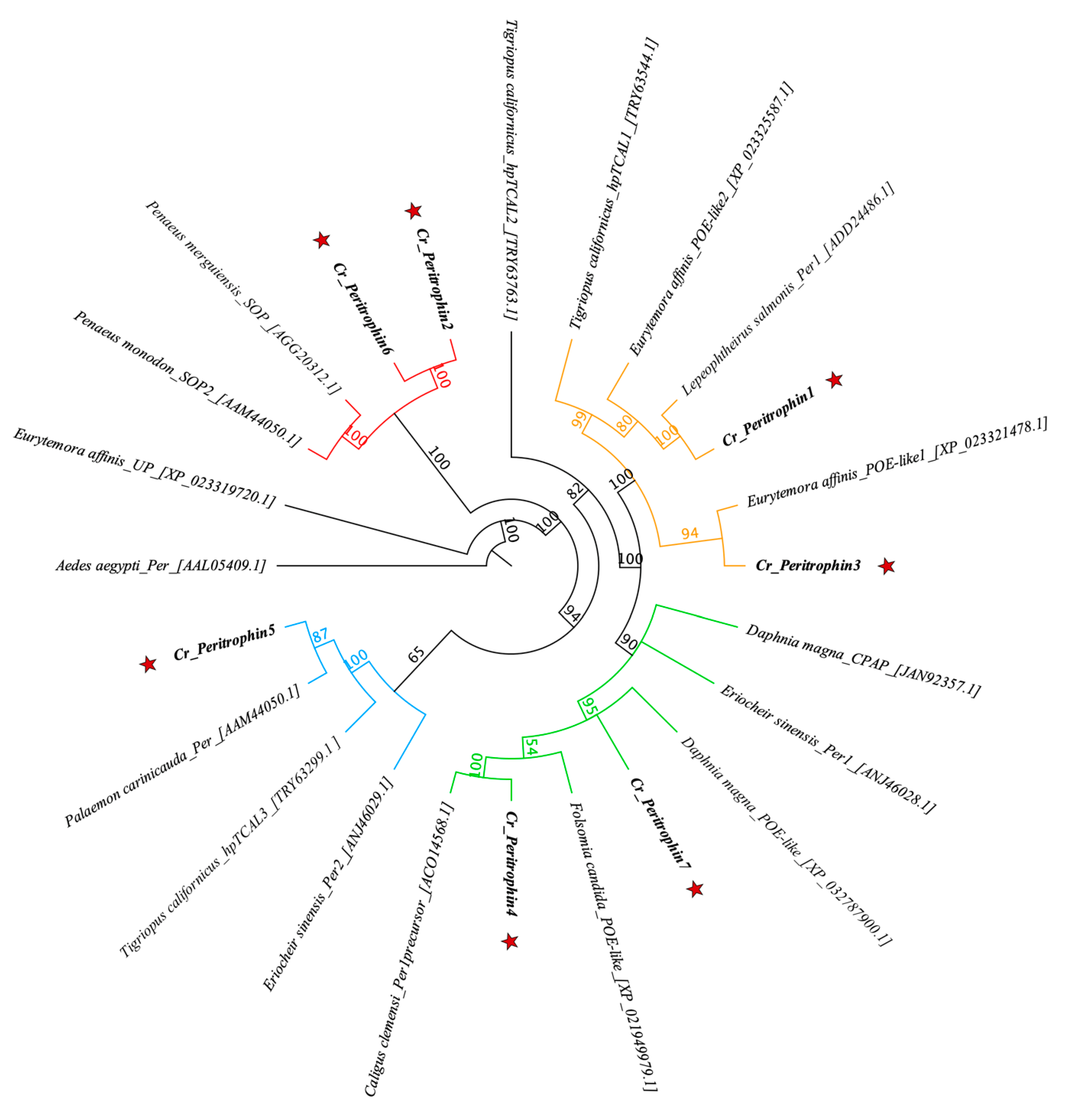
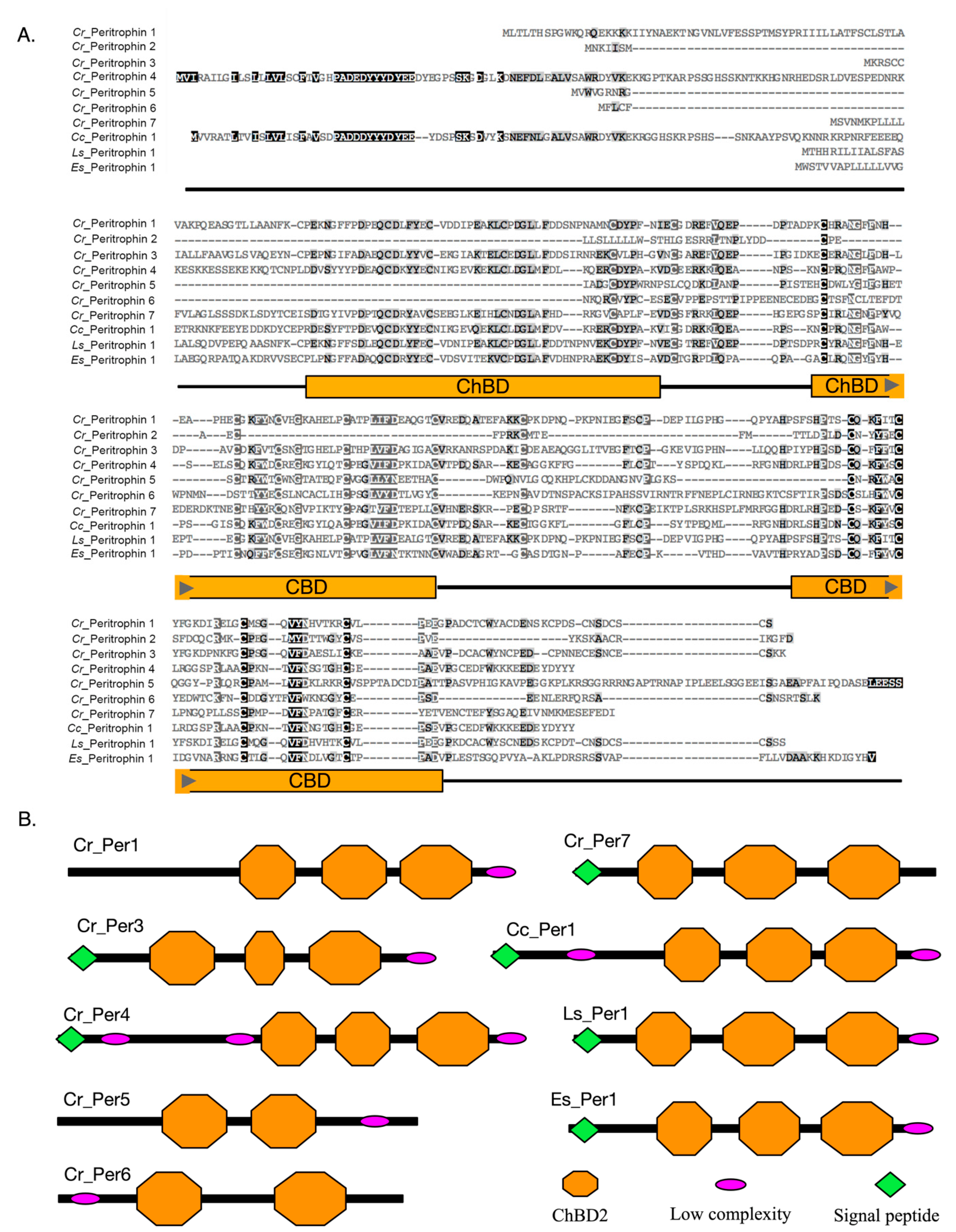
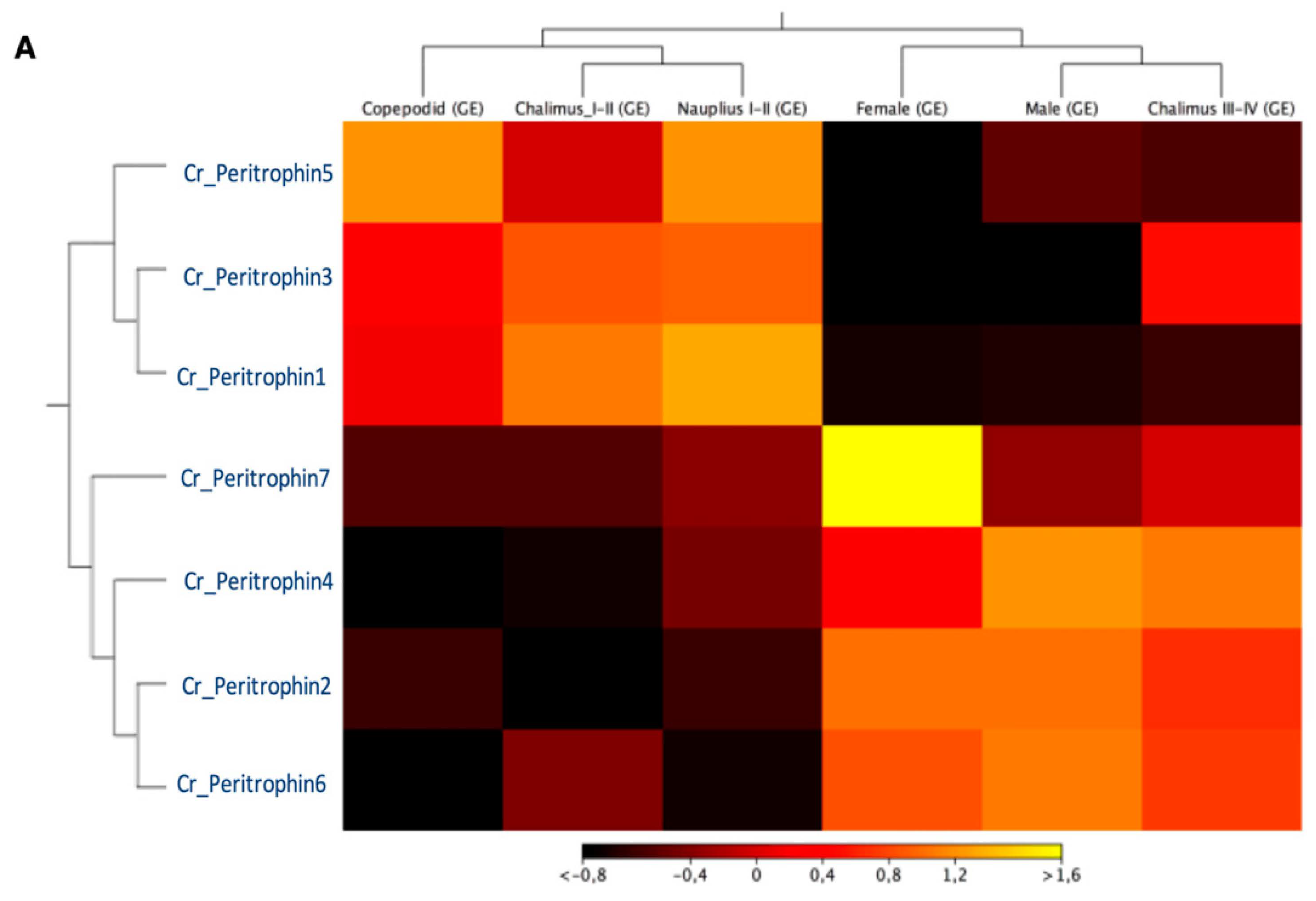

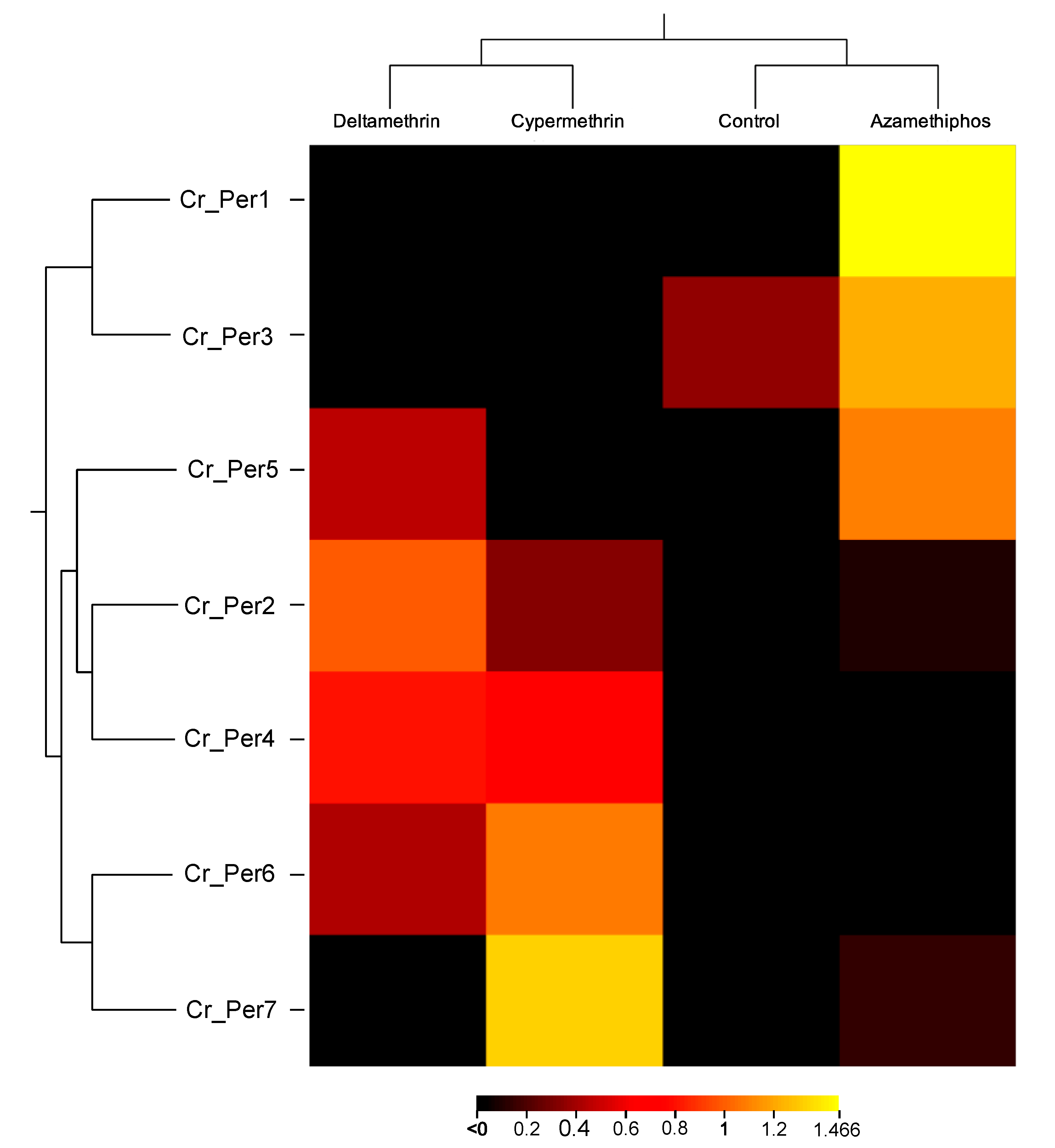
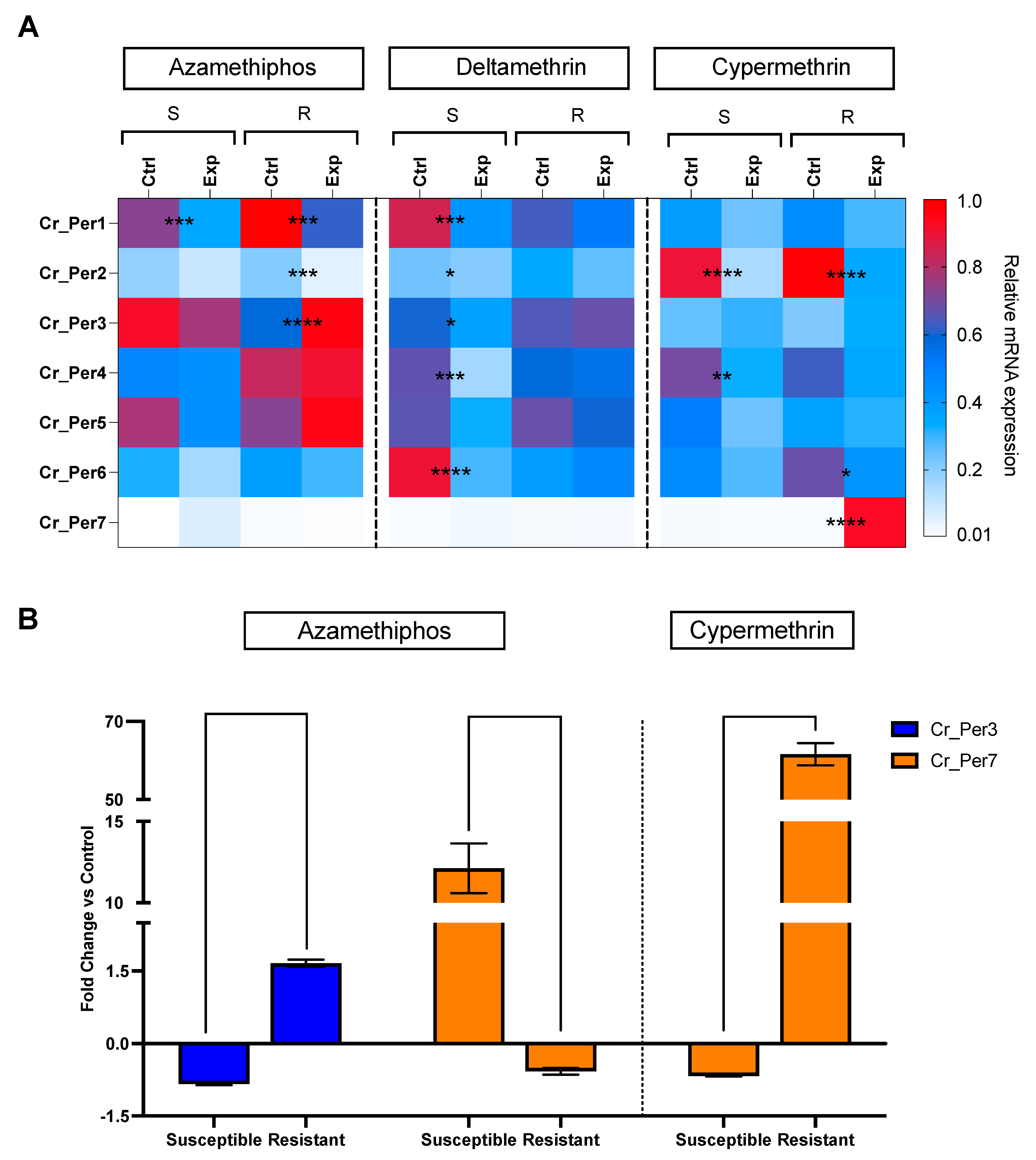
| C. rogercresseyi Peritrophins | ORF Length (bp) | Translate Sequence (aa) | MW (KDa) | pI | α Helix (%) | β Strand (%) | O-Linked Glyc | N-Linked Glyc | Protein Subcellular Prediction |
|---|---|---|---|---|---|---|---|---|---|
| Cr_Per1 | 924 | 307 | 34.163 | 5.08 | 9 | 24 | 6 | Not found | Cell membrane |
| Cr_Per2 | 315 | 104 | 12.141 | 5.04 | 37 | 21 | 1 | Not found | Extracellular |
| Cr_Per3 | 768 | 255 | 27.881 | 4.65 | 11 | 20 | 3 | 1, * | Extracellular |
| Cr_Per4 | 1008 | 335 | 38.324 | 5.4 | 3 | 30 | 13 | * | Extracellular |
| Cr_Per5 | 663 | 220 | 24.117 | 5.97 | 1 | 20 | 9 | 1, * | Extracellular |
| Cr_Per6 | 591 | 196 | 22.352 | 4.57 | 14 | 34 | 3 | 1 | Extracellular |
| Cr_Per7 | 783 | 260 | 29.61 | 5.33 | 10 | 16 | 7 | 1 | Extracellular |
| C. rogercresseyi Peritrophins | Gene Copies | Chromosome | No. of Exons | Start Position (nt) | Final Position (nt) |
|---|---|---|---|---|---|
| Cr_Per1 | 1 | 11 | 1 | 32,016,274 | 32,016,768 |
| Cr_Per2 | 1 | 3 | 1 | 26,035,334 | 26,035,644 |
| Cr_Per3 | 1 | 19 | 1 | 11,957,508 | 11,958,268 |
| Cr_Per4 | 1 | 12 | 1 | 14,772,262 | 14,772,731 |
| Cr_Per5 | 1 | 11 | 2 | 32,986,846 | 32,987,474 |
| Cr_Per6 | 1 | 9 | 1 | 5,738,200 | 5,738,500 |
| Cr_Per7 | 1 | 6 | 1 | 5,486,856 | 5,487,637 |
| Primer Name | Sequence | Mold Sequence | Tm (°C) | Efficiency (%) |
|---|---|---|---|---|
| Cr_Peritrophin1_F | TCTTCAACCATGAGGCACCC | contig10 | 60 | 112.4 |
| Cr_Peritrophin1_R | GGCCTCGTCGAAGATCAGAG | |||
| Cr_Peritrophin2_F | CCCGAAGACTCACCAATCCC | contig 4784 | 60 | 118.6 |
| Cr_Peritrophin2_R | GGCAGTCGAAGGAACACTCA | |||
| Cr_Peritrophin3_F | TCGTGAGTTTGTCCAGGAGC | contig 6390 | 60 | 112.2 |
| Cr_Peritrophin3_R | AAGGAAGCTCATGTCCCGTG | |||
| Cr_Peritrophin4_F | GGACTATGAGGGCCCTTCCT | contig 12860 | 60 | 110 |
| Cr_Peritrophin4_R | GGTGGGGCCTTTCTTTTCCT | |||
| Cr_Peritrophin5_F | CCCCTTGGAAAGTCCTGCAA | contig0002090 | 60 | 105 |
| Cr_Peritrophin5_R | CGCTTGCGGAGTTTGTCAAA | |||
| Cr_Peritrophin6_F | GCAAATCAATCCCAGCCCAC | contig4172 | 60 | 112.6 |
| Cr_Peritrophin6_R | CCGAGGGGCGTATCGTAAAA | |||
| Cr_Peritrophin7_F | AGATCCAAACGCCCAGAGTG | contig8519 | 60 | 109 |
| Cr_Peritrophin7_R | GGAGCAGTCTTCTGGGTGAC |
Publisher’s Note: MDPI stays neutral with regard to jurisdictional claims in published maps and institutional affiliations. |
© 2022 by the authors. Licensee MDPI, Basel, Switzerland. This article is an open access article distributed under the terms and conditions of the Creative Commons Attribution (CC BY) license (https://creativecommons.org/licenses/by/4.0/).
Share and Cite
Casuso, A.; Núñez-Acuña, G.; Valenzuela-Muñoz, V.; Sáez-Vera, C.; Gallardo-Escárate, C. Peritrophin-like Genes Are Associated with Delousing Drug Response and Sensitivity in the Sea Louse Caligus rogercresseyi. Int. J. Mol. Sci. 2022, 23, 13341. https://doi.org/10.3390/ijms232113341
Casuso A, Núñez-Acuña G, Valenzuela-Muñoz V, Sáez-Vera C, Gallardo-Escárate C. Peritrophin-like Genes Are Associated with Delousing Drug Response and Sensitivity in the Sea Louse Caligus rogercresseyi. International Journal of Molecular Sciences. 2022; 23(21):13341. https://doi.org/10.3390/ijms232113341
Chicago/Turabian StyleCasuso, Antonio, Gustavo Núñez-Acuña, Valentina Valenzuela-Muñoz, Constanza Sáez-Vera, and Cristian Gallardo-Escárate. 2022. "Peritrophin-like Genes Are Associated with Delousing Drug Response and Sensitivity in the Sea Louse Caligus rogercresseyi" International Journal of Molecular Sciences 23, no. 21: 13341. https://doi.org/10.3390/ijms232113341
APA StyleCasuso, A., Núñez-Acuña, G., Valenzuela-Muñoz, V., Sáez-Vera, C., & Gallardo-Escárate, C. (2022). Peritrophin-like Genes Are Associated with Delousing Drug Response and Sensitivity in the Sea Louse Caligus rogercresseyi. International Journal of Molecular Sciences, 23(21), 13341. https://doi.org/10.3390/ijms232113341








